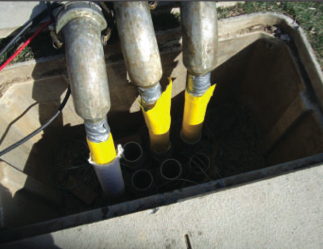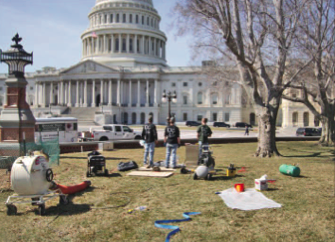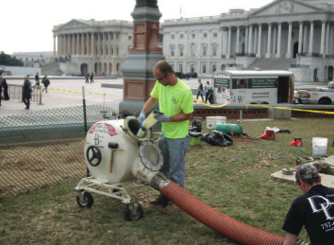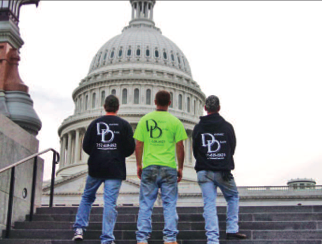 Our advanced repiping systems allow us to repair or rehabilitate electrical conduit lines without the need for major excavations. Many times replacing old conduit can be a daunting task due to the structures that these lines pass through.
Our advanced repiping systems allow us to repair or rehabilitate electrical conduit lines without the need for major excavations. Many times replacing old conduit can be a daunting task due to the structures that these lines pass through.
Most conduit is an electrical piping system that is used for protecting and routing electrical wiring. It is usually made up of metal, plastic, fiber or fired clay. There are also flexible versions that allow slight bends to be negotiated. This is also why relining the pipes instead of excavating them is a solid choice. Many times these pipes are found in sensitive locations that would require shutting down services and/or access during maintenance. If you do decide to reline them using the CIPP system your business can stay open and employees can continue to work without being disrupted.
If there are any types of imperfections in the pipe such as couplings becoming offset or rust or leaks, relining them with CIPP will resolve all of these issues. The replacement pipe will contain no joints or seams. This will replace any snags or places where electrical wiring would become hung up with one continuous flowing pipe.
 Our work on the capitol building in Washington DC allowed us to get the job done with minimal disruptions. The plumbing contractor brought us in to save time and money. Not only are the requirements for a government job like this extremely stringent, the excavations that would have been required would have taken weeks. All employees would have to pass background and drug tests. Equipment would have been required to stay off site overnight. And also a time frame of three days is the maximum amount of time an outside contractor can work consecutively on any job. Not to mention the capitol building had to staff armed guards to supervise the work being done.
Our work on the capitol building in Washington DC allowed us to get the job done with minimal disruptions. The plumbing contractor brought us in to save time and money. Not only are the requirements for a government job like this extremely stringent, the excavations that would have been required would have taken weeks. All employees would have to pass background and drug tests. Equipment would have been required to stay off site overnight. And also a time frame of three days is the maximum amount of time an outside contractor can work consecutively on any job. Not to mention the capitol building had to staff armed guards to supervise the work being done.
You can read about the job on our blog here: https://www.dynamicdraintechnologies.com/cipp-reline-repair-washington-dc-conduit/
Getting Wired
Electrical conduit is good for providing protection to enclosed conductors. This keeps essential wiring components protected from impact, moisture and chemical vapors. Conduit can contain a number of varying conductors making design and expense simple and cost effective. These wiring systems are often subject to frequent alterations so conduit makes this a safer change as opposed to multiple runs of cable or customized composite cable systems. Conduit systems can be made waterproof and can even go underwater.
Usually these lines are encased in concrete in commercial buildings to provide electrical flow and communication outlets in common areas. The cost of conduit installation is higher than other methods. If there is no concern for physical damage the expense of conduit may not be warranted.
Metal conduits include:
- Rigid Metal Conduit (RMC) – thick threaded tubing commonly made with coated steel, stainless steel or aluminum.
- Galvanized Rigid Conduit (GRC) – thick enough to be threaded to allow multiple sections the be screwed together.
- Intermediate Metal Conduit (IMC) – heavier than EMT but lighter than RMC and may be threaded.
- Electrical Metallic Tubing (EMT) – thin-wall, can not be threaded but can be clamped together
- Aluminum Conduit – provides high resistance to corrosion often used in food processing plants
Non-Metal Conduits Include:
- Polyvinyl chloride (PVC) – is the most commonly produced and lightweight material. It can be bent and threaded.
- Rigid Nonmetallic Conduit (RNMC) – unthreaded tubing
- Electrical Nonmetallic Tubing (ENT) – thin-walled and moisture resistant. It is also flexible and flame retardant. Fittings can be threaded.
Flexible Conduits Include:
- Flexible Metallic Conduit (FMC) – often called greenfield or flex. Used in dry areas and is usually a ribbed strip of aluminum or steel. These are usually smaller cables that we would not be able to reline.
- Liquidtight Flexible Metal Conduit (LFMC) – same as FMC except it is covered witha waterproof plastic coating.
- Flexible Metallic Tubing (FMT) – is a raceway and not described as a conduit
- Liquidtight Flexible Nonmetallic Conduit (LFNC) – refers to several types of non-metallic tubing. Also known as FNMC
Underground Conduit:
This is what we are called to reline the most. Conduit that goes between buildings, under structures or devices that allow power and communication cables to pass. These conduits often called a duct bank, may either be buried in earth or encased in concrete often times with rebar to aid against shear.
Compressed asbestos fiber mixed with cement (such as transite) was the most popular fashion of underground installations of electrical conduit. Fired-clay conduit was typically used for telephone and communication circuits.
